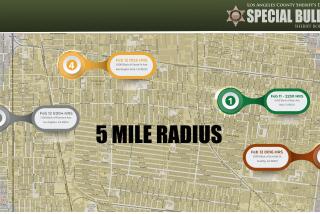Trial Begins for 2 Youths in Shotgun Slayings of 3 Teen-Age Girls : Courts: The defendants, 17 and 18, face separate juries. Lawyers blame the other’s client for the murders.
- Share via
Lawyers for the two youths charged with the shotgun slayings of three teen-age girls during a drunken gathering last year in a hillside home in Pasadena quickly turned on each other’s clients in opening statements in Pasadena Superior Court on Monday.
Attorney Rickard Santwier noted that his client, Vincent Burton Hebrock, 18, was alleged to have said to his co-defendant after the killings on March 21, 1991, “Yeah, dude, we smoked ‘em all.”
“What if you change one word in there, and he said, ‘Yeah, dude, you smoked ‘em all’? “ Santwier asked, looking pointedly at co-defendant David Russell Adkins, 17.
Adkins’ lawyer, Stephen Romero, countered that his client never touched the murder weapon and had been “hugging and kissing” his girlfriend, Kathy Macaulay, while Hebrock engaged in a “knock-down-drag-out fight” with Heather Goodwin and Danae Palermo.
Palermo, 17, and Macaulay and Goodwin, both 18, were found shot to death in a garage apartment in Macaulay’s home in the upscale Annandale section of Pasadena, where they had gathered with the two defendants and a third youth to drink alcohol and listen to music.
Adkins and Hebrock were arrested the day after the murders in Salem, Ore., where they had allegedly driven in a stolen Mercedes-Benz belonging to Macaulay’s stepfather, pathologist Michael Koss. The murder weapon, a 12-gauge Mossberg shotgun, was found near a bicycle path in Grants Pass, Ore.
Deputy Dist. Atty. Nancy Naftel, in her opening statement, recounted the events she said occurred after the six teen-agers, all of them current or former students in South Pasadena public schools, gathered that afternoon in the garage apartment.
Using aerial photographs of the scene of the crime, Naftel showed the jury that the apartment--friends referred to it as “Kathy’s house”--is part of a small compound with a patio and a larger house, all owned by Koss and Kathy Macaulay’s mother, Linda Macaulay. Both were at a convention in Chicago when the murders occurred.
The teen-agers bought a case of beer and a fifth of Jack Daniels whiskey, all of which they consumed, along with marijuana, Naftel said. When Kathy Macaulay, Adkins and Cayle Fiedler, the third male at the party, went for more beer, Hebrock fought with the other two girls, Naftel said.
After the fight, Hebrock and Adkins took a shotgun from the main house, returned to the garage apartment and killed the girls, shooting each once in the head at close range, Naftel said. Hebrock shot Macaulay, and Adkins shot Goodwin and Palermo, Naftel contended.
Both defense lawyers assailed the credibility of Fiedler, 17, the prosecution’s key witness, who in pretrial testimony has told of awakening from a drunken stupor to see one of the girls shot as she lay on a bed next to him.
Fiedler testified in a preliminary hearing last year that Hebrock boasted about having “smoked” the girls. He also testified that Adkins said in the moments after the killings, “I just killed my girlfriend,” and that Hebrock said during the same exchange, “She’ll never do that again.”
Naftel contended that Hebrock was referring to Heather Goodwin, who had kicked Hebrock in the groin during their fight.
Both defense lawyers suggested that Fiedler was either too drunk to remember what happened that night or else that he himself may have been implicated in the murders.
The trial, which is expected to last four weeks, is being held with two juries, one for each defendant. Judge J. Michael Byrne agreed to separate juries after the defense lawyers cited a 1965 state Supreme Court ruling that statements made by one defendant cannot be presented verbatim if they are damaging to another defendant.
Santwier and Romero addressed different juries, and Naftel delivered separate opening statements.
The prosecutor appeared to acknowledge Monday that authorities are still perplexed about why the killings occurred.
“We may or may not be able to establish what the motive was,” Naftel told one jury. “But motivation is not something I am required to prove.”
More to Read
Sign up for Essential California
The most important California stories and recommendations in your inbox every morning.
You may occasionally receive promotional content from the Los Angeles Times.













